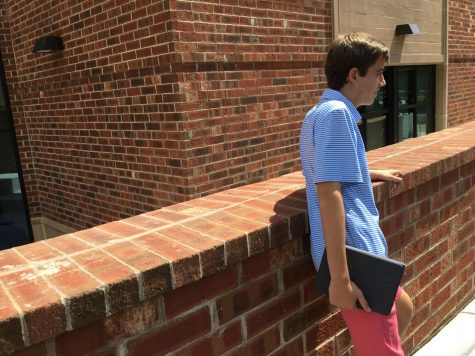Latin Homecoming: The True Spirit of the White and Blue
December 16, 2019
Football. Tailgating. Alumni. Dancing. Every fall, schools around the country host a “homecoming” football game. Homecoming is a long-standing American tradition in which high schools and colleges welcome back alumni to their campuses and communities. The University of Illinois and the University of Missouri both defend their title of holding “the largest student-run homecoming.” Todd McCubbin, executive director of the Mizzou Alumni Association said in an article entitled “The First Homecoming: Missouri helped invent a college football tradition” for “Saturday Down South” online, “I don’t know if it even matters whether we were the first, it’s like our journalism school. People don’t attend because it’s the oldest, but because it’s the best. We think we do homecoming well.”
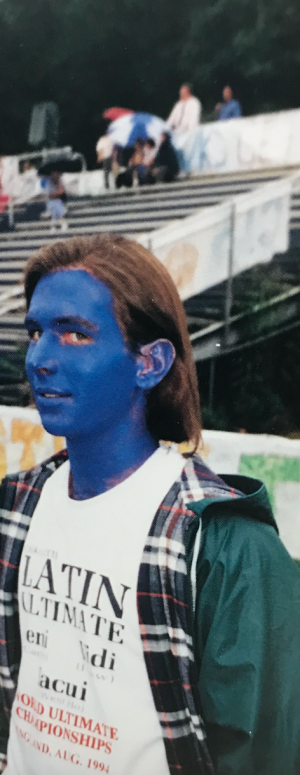
Carter Robinson throws himself into homecoming and becomes one with the spirit of the Hawks in 1996.
Nonetheless, according to Christopher Smith’s article for “Saturday Down South” online, the 1911 tradition truly began with the University of Missouri’s athletic director, Chester Brewer, who saw the game as an opportunity for excitement and invited the alumni to come home and enjoy the game. Surprisingly, 12,000 alumni attended the first game (a number that exceeded the available seating in the stadium). From there, the tradition continued to evolve and and students embrace the enthusiasm for the event, organizing pep-rallies and spirit weeks; however, one of the biggest traditions remains tailgating before the game. Tailgating events also began to reflect themes as their popularity grew, which is another aspect of homecoming attributed to the University of Missouri.
Schools today also enjoy electing a homecoming court that includes attendants from all four classes and a king and queen (who are usually elected from the senior class), even though the criteria for the election or selection might vary per school. For example, some schools require court nominees be in good standing academically and have strong character references; other schools dictate court members be members of varsity teams, while still others have no requirements of any kind other than majority votes of their peers. Charlotte Latin has its own criteria for homecoming court—and while the court is recognized by the entire school, only the Upper School participates in the actual voting.
This year, Thomas Cashion was voted king; the winner is announced at the all-School pep-rally. In some schools, the female members of the court are the only nominees; they then choose their escorts while in other schools, the males are also chosen by student body votes. At Latin, there is one female nominee (elected by the students in Upper School) for every grade in Upper School. Later that Friday night at halftime during the homecoming game, Latin traditionally announces the name of the homecoming queen. This year, it was Laura Zielinski (again, as is tradition at Latin, the queen, like the king, is always a senior).
Charlotte Latin also organizes Touchdown Tailgate, which is a school-wide pre-game community
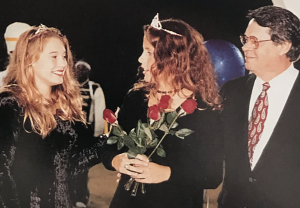
1993 homecoming queen Keri Zuger returns to Latin to crown Walker Stroud for 1994. Zuger gives Stroud a congratulating word as Stroud’s father looks on proudly. The crowning of the queen is a very exciting part of any homecoming game.
event. However, this type of event is relatively new at Charlotte Latin School. Janis Mishoe ‘96, admissions application coordinator at Charlotte Latin School said, “I don’t remember a large gathering like Touchdown Tailgate before the football game. I am glad they have added the tradition! It makes the event more festive!” Ed Fox, Middle School science teacher and Latin alumni ‘80 said, “I don’t remember homecoming being that big of a deal in the late 1970s. There was a dance, but I don’t remember that people got dressed up.”
Latin Upper School students have incorporated dinner
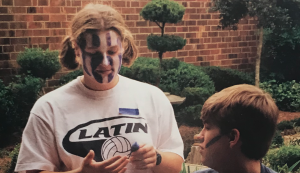
Megan Lew applies face paint onto Ben Vandiver so he join in with the homecoming festivities circa 1996.
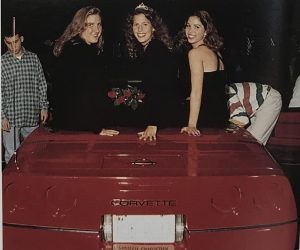
(sometimes with dates but often with groups) as part of the pre-dance homecoming experience. Back in 2008, popular choices for dinner were Firebirds, Brio, Red Rocks and friends’ houses, according to statistics recorded in Latin’s 2008 “Eyry” yearbook. When compared to the 42 polled students from the senior class of 2020 for this year’s homecoming, their preferences were similar (Brio’s, Bricktops, 131 Main and The Original House of Pancakes). The dance is still the highlight of the evening for Latin Upper School students. This year’s freshman class reported their satisfaction with the event based on their 39 polled responses. Gabe Stein ‘23 said, “The food was good, the DJ was good, the room was very well-decorated and people were mostly behaving responsibly.” Although the dance is notoriously crowded, students generally appreciate this as part of the charm. “I think it’s a fun, unique little tradition Latin has,” Alex Baldecchi ‘23 said. Jordan Jemsek ‘23 said, “It was mostly people just stepping on my feet the whole time and not being able to see anyone, but it was still super fun.”
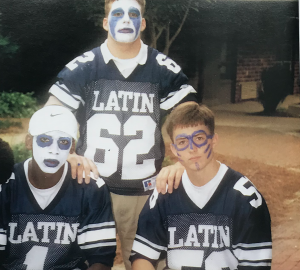
Brad Jones, Seneca Redwood Sawyer and Davis Hankins prepare for their big homecoming game by painting their faces in Latin blue and white.
Student council was responsible for selecting the theme for the dance (“Under the Sea,” for 2019) as well as the set-up. While the students have a great time attending the dance, there are costs involved with the attendance, particularly if students add in the price of dinners, corsages and the purchase of new clothing for some students. 30% of students polled in the class of 2020 met at Brio’s and enjoyed dinner before dance. Additionally, over 40% of those students spent over $100 in total on the expenses of the dance (including dinner, flowers, clothes, etc.).
Regardless of the decade, homecoming at Latin remains a tradition that brings the School community together. Whether it continues to evolve and becomes even more elaborate remains unknown, but Hawks of the future will likely report a consistent desire to celebrate their love for the blue and white, the dance floor and just celebrating spending time together.

